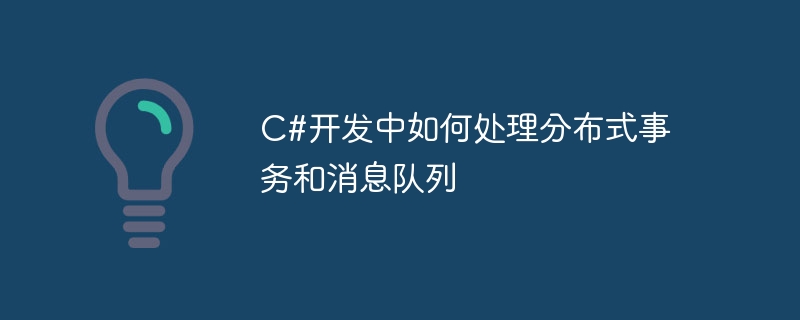Home >Backend Development >C#.Net Tutorial >How to deal with distributed transactions and message queues in C# development
How to deal with distributed transactions and message queues in C# development
- 王林Original
- 2023-10-09 11:36:181311browse

#How to deal with distributed transactions and message queues in C# development
Introduction:
In today's distributed systems, transactions and message queues are very important components. Distributed transactions and message queues play a crucial role in handling data consistency and system decoupling. This article will introduce how to handle distributed transactions and message queues in C# development, and give specific code examples.
1. Distributed transactions
Distributed transactions refer to transactions that span multiple databases or services. In distributed systems, how to ensure data consistency has become a major challenge. The following introduces two commonly used methods for processing distributed transactions:
- Two-phase Commit (two-phase commit)
Two-phase Commit (2PC) is a way to ensure that distributed system transactions are consistent sexual agreement. Its basic idea is that the coordinator (Coordinator) divides the global transaction into the Prepare phase and the Commit phase, and ultimately decides whether to commit or rollback the transaction through interaction with each participant (Participant). Here is a simple code example:
public void TwoPhaseCommit()
{
using (var scope = new TransactionScope())
{
try
{
// 执行分布式事务操作1
DoSomethingWithDatabase1();
// 执行分布式事务操作2
DoSomethingWithDatabase2();
// 事务提交
scope.Complete();
}
catch (Exception ex)
{
// 事务回滚
scope.Dispose();
}
}
}- Saga Pattern
The Saga pattern is a solution for handling distributed transactions by splitting a large transaction into multiple smaller ones. Transactions, each small transaction has independent rollback logic and compensation operations to ensure eventual consistency. The following is a simple Saga mode code example:
public void SagaDemo()
{
try
{
// 执行分布式事务操作1
DoSomethingStep1();
// 执行分布式事务操作2
DoSomethingStep2();
// 执行分布式事务操作N
DoSomethingStepN();
// 事务提交
Commit();
}
catch (Exception ex)
{
// 发生异常,执行事务的回滚逻辑
Rollback();
}
} 2. Message Queue
Message queue is a way of transmitting messages in a distributed system. It has decoupling, Advantages such as asynchronous and peak-shaving and valley-filling. Here's how to use RabbitMQ as a message queue:
- Installing RabbitMQ
First, you need to install RabbitMQ. You can download and install RabbitMQ by visiting the RabbitMQ official website (https://www.rabbitmq.com/). -
Create message producer
using RabbitMQ.Client; public class MessageProducer { public void SendMessage() { var factory = new ConnectionFactory() { HostName = "localhost" }; using (var connection = factory.CreateConnection()) using (var channel = connection.CreateModel()) { channel.QueueDeclare(queue: "message_queue", durable: false, exclusive: false, autoDelete: false, arguments: null); string message = "Hello, World!"; var body = Encoding.UTF8.GetBytes(message); channel.BasicPublish(exchange: "", routingKey: "message_queue", basicProperties: null, body: body); Console.WriteLine("Sent message: {0}", message); } } } -
Create message consumer
using RabbitMQ.Client; using RabbitMQ.Client.Events; public class MessageConsumer { public void ConsumeMessage() { var factory = new ConnectionFactory() { HostName = "localhost" }; using (var connection = factory.CreateConnection()) using (var channel = connection.CreateModel()) { channel.QueueDeclare(queue: "message_queue", durable: false, exclusive: false, autoDelete: false, arguments: null); var consumer = new EventingBasicConsumer(channel); consumer.Received += (model, ea) => { var body = ea.Body.ToArray(); var message = Encoding.UTF8.GetString(body); Console.WriteLine("Received message: {0}", message); }; channel.BasicConsume(queue: "message_queue", autoAck: true, consumer: consumer); Console.WriteLine("Waiting for messages..."); Console.ReadLine(); } } }
Summary:
Introduction to this article Learn how to handle distributed transactions and message queues in C# development, and give specific code examples. Distributed transaction processing methods include Two-phase Commit and Saga mode, and the use of message queues can be implemented through RabbitMQ. In actual development, selecting appropriate processing methods and message queues based on specific business scenarios and needs can improve the stability and scalability of the system.
The above is the detailed content of How to deal with distributed transactions and message queues in C# development. For more information, please follow other related articles on the PHP Chinese website!

